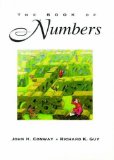Book Review: The Book of Numbers
The Book of Numbers is a wonderful book about, well, numbers. And lots of them. From ancient ways of writing numbers to Gaussian integers to surreal numbers. The authors are some tough mathematicians, too. John H. Conway is Professor of Mathematics at Princeton University, an authority in game theory and group theory, and the inventor of the Game of Life and surreal numbers. Richard K. Guy is professor emeritus of mathematics at the University of Calgary and has (co)authored several hundred publications on combinatorial game theory, number theory and graph theory.
The number of topics in the book is huge. Some of them are listed here, according to the chapters in which they appear:
- 1. The Romance of Numbers is on how to write numbers. Number words, writing big numbers (such as million, quadrillon, googol), ancient number systems (greek, roman, egyptian, hindu-arabic).
- 2. Figures from Figures: Doing Arithmetic and Algebra by Geometry. By arranging colored pebbles in different spacial configurations, this chapter derives all kinds of formulas for, among others, triangular, square, pentagonal, hexagonal, tetrahedral, square pyramid, octahedral, and rhombic dodecahedral numbers.
- 3. What Comes Next? This chapter addresses combinatorial enumerations (arrangement numbers/permutations, choice numbers/combinations, choice numbers with repetitions/multicombinations) as well as Pascal's triangle and Binomial coefficients. It also looks at Moessner's magic, a way to derive many integer sequences, and frieze patterns.
- 4. Famous Families of Numbers treats Bell numbers, Bernoulli numbers, Catalan numbers, Euler numbers, Fibonacci numbers, Ramanujan's numbers, Stirling numbers. It also has an illustrative section on Phyllotaxis, how and why Fibonacci numbers appear in nature.
- 5. The Primacy of Primes. This chapter looks at sieve of Eratosthenes, modular arithmetic, Mersenne's numbers, perfect numbers, Fermat's numbers, Fermat's test for primes, and the frequency of prime numbers.
- 6. Further Fruitfulness of Fractions. Some topics are Farey fractions and Ford circles, Euler's totient numbers, decimal digit cycles, Pythagorean fractions, continued fractions.
- 7. Geometric Problems and Algebraic Numbers. This chapter turns to the irrationality of the square root of 2, Lagrange/Markov numbers, Freiman's number, algebraic numbers, ruler and compass constructions, constructing regular polygons, Calabi's triangle, Graham's biggest little hexagon, periodic points, and the look and say sequence
- 8. Imagining Imaginary Numbers treats adding and multiplying by geometry, Gauss' whole numbers, Eisenstein integers, the nine magic discriminants, De Moivre's circle-cutting numbers, the regular heptadecagon, hypercomplex numbers, quaternions, Cayley numbers
- 9. Some Transcendental Numbers. In this chapter, the authors look at pi, Liouville's number, Gregory's numbers, Størmer's numbers, logarithms, powers of e, Euler's wonderful relation, harmonic numbers, the Euler-Mascheroni number, Stirling's formula, Apéry's number
- 10. Infinite and Infinitesimal Numbers finishes with topics like Cantor‘s ordinal numbers, cardinal numbers, surreal numbers, the game of Hackenbush, nimbers, the game of Nim, and orders of infinity
With this amount of topics and only 300 pages, no topic is treated in depth, some taking up only half a page. But many of the facts stated or questions raised in this book are nontrivial. I found myself repeatedly staring blankly into the air, wondering about some result or comment from the book—or simply thinking that I had to find some more information on this subject. And that is, in my opinion, a great quality for a math book. Each chapter finishes with a list of references, so the reader has some starting points for further material.
It should be noted that each chapter can be read independently of the others. So you should be able to dive into a single chapter without reading the previous chapter.
You have to have some knowledge of mathematics to enjoy this book. The first chapter (on different number systems and ways to write numbers) is mostly pure text. But the subsequent chapters are mostly formulas and figures, facts and theorems. A high school mathematics level, or equivalent, should be sufficient to enjoy most of the book, though.
It was a joy to read this book. I highly recommend it.
Book facts:
- Book title: The Book of Numbers.
- Authors: John H. Conway and Richard K. Guy.
- Publication year: 1996.
- Publisher: Springer.
- ISBN: 978-0-387-97993-9.

